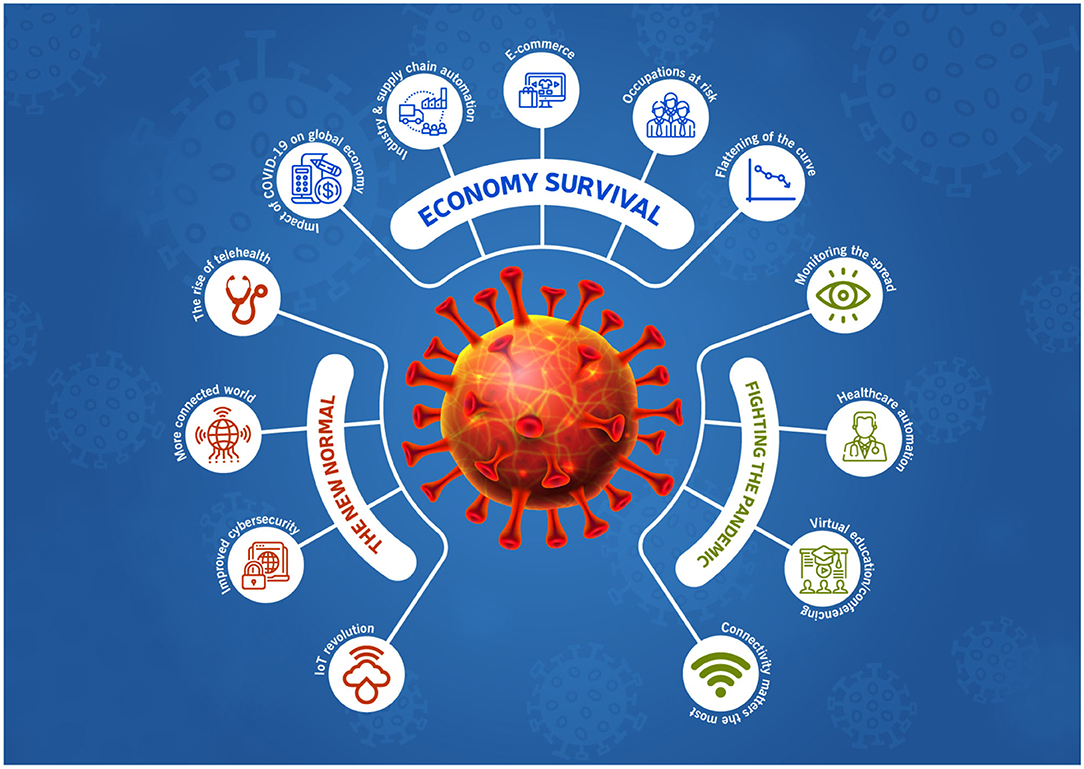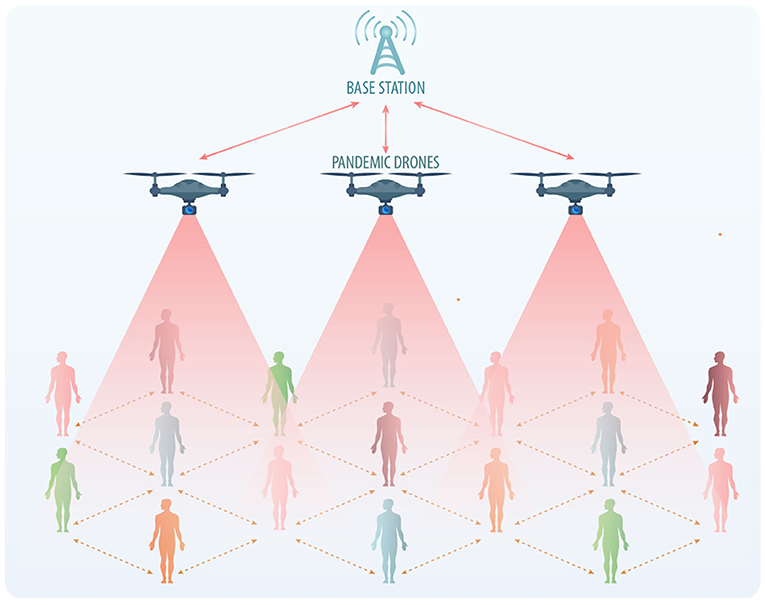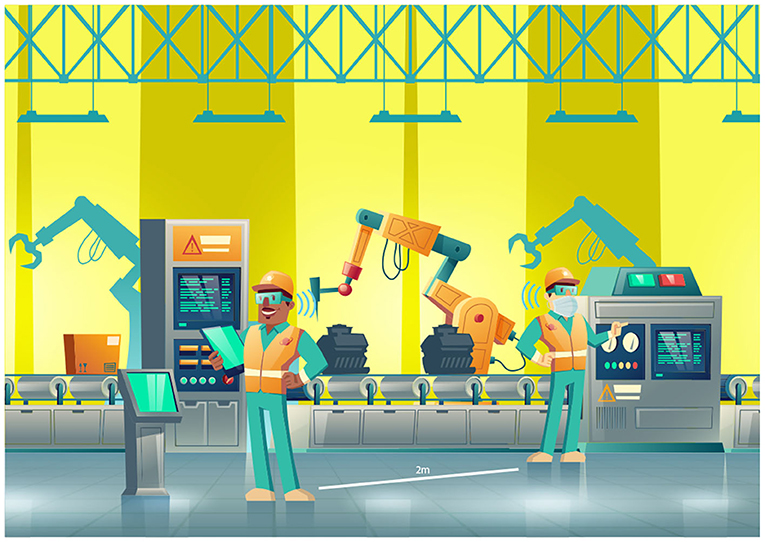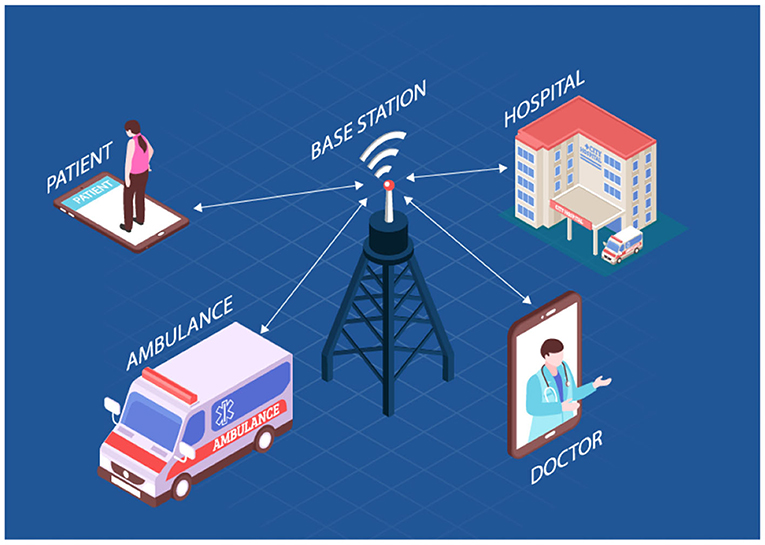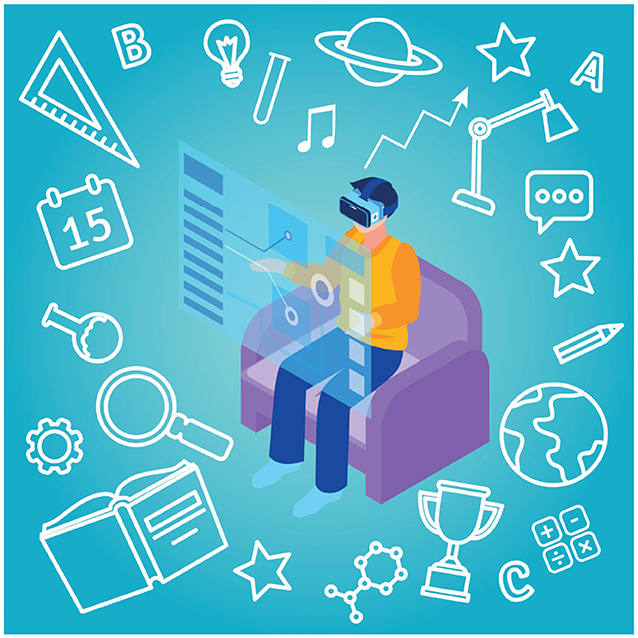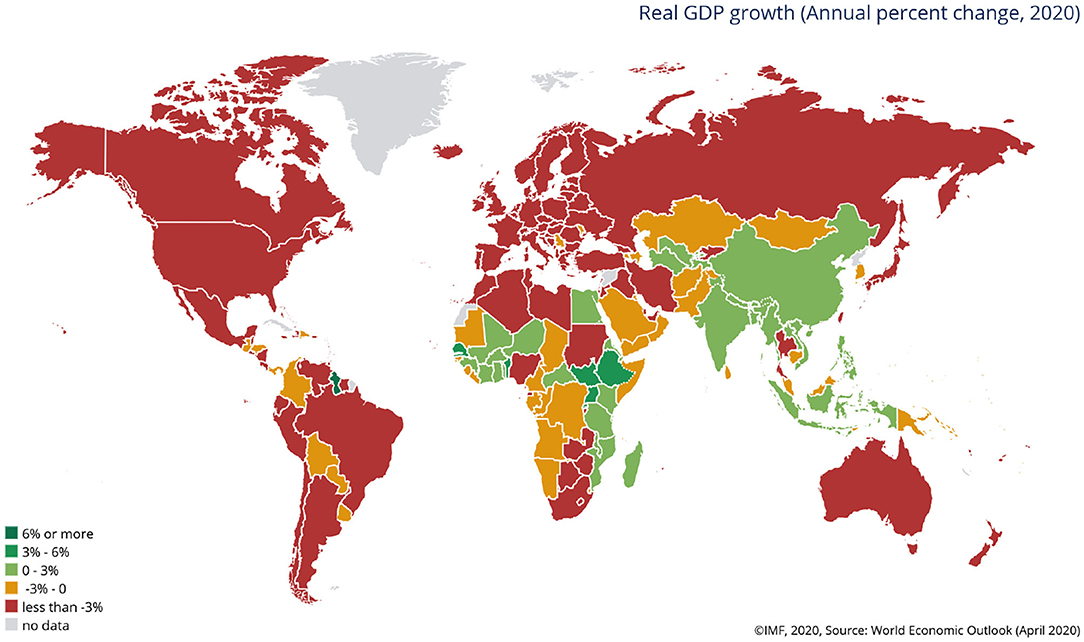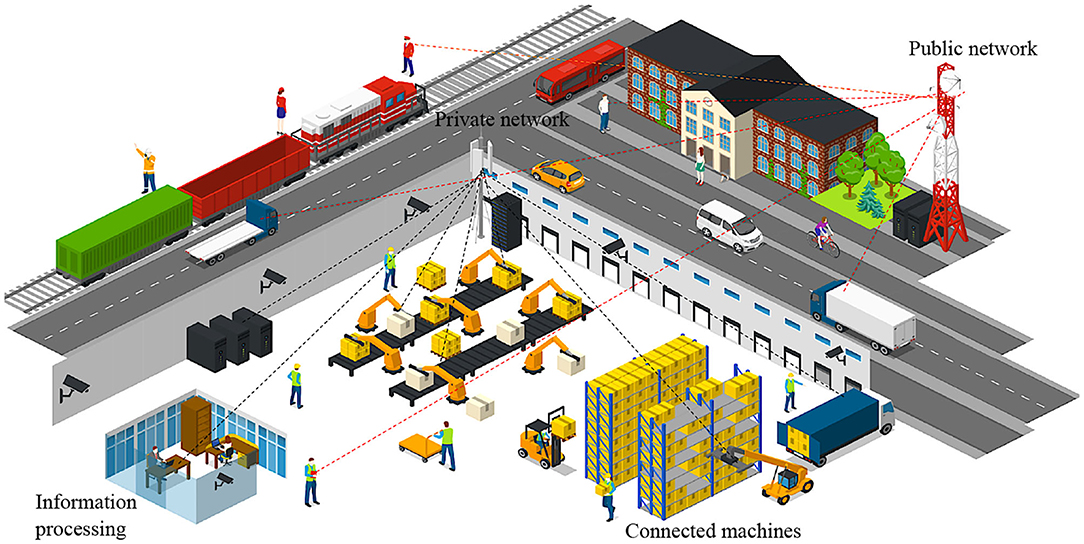- 1King Abdullah University of Science and Technology (KAUST), Thuwal, Saudi Arabia
- 2Insyab Wireless Limited, Dubai, United Arab Emirates
The year 2020 is witnessing a global health and economic crisis due to the COVID-19 pandemic. Countries across the world are using digital technologies to fight this global crisis. These digital technologies strongly rely, in one way or another, on the availability of wireless communication systems. This paper aims to outline the role of wireless communications in the COVID-19 pandemic from multiple perspectives. First, we show how wireless communication technologies are helping to combat this pandemic by monitoring the spread of the virus, enabling healthcare automation, and enabling virtual education and conferencing. We emphasize the importance of digital inclusiveness in the pandemic and possible solutions to connect the unconnected. Next, we discuss the challenges posed by the use of wireless technologies, including concerns about privacy, security, and misinformation. Later, we highlight the importance of wireless technologies in the survival of the global economy, such as automation of industries and supply chain, e-commerce, and supporting occupations that are at risk. Finally, we outline that the rapid development of wireless technologies during the pandemic is likely to be useful in the post-pandemic era.
1. Introduction
Coronavirus disease (COVID-19) is an infectious respiratory disease that originated from the city of Wuhan, China, in December 2019 and spread worldwide (Zhu et al., 2020). COVID-19 has affected almost all the countries in the world, significantly disrupting the noble sustainable development goals (SDGs) of the United Nations (UN) (Gallagher et al., 2020) and prompting the World Health Organization (WHO) to declare the virus a global pandemic in March 2020. COVID-19 has caused a great deal of panic around the globe, which has resulted in, among other things, supply chain disruption for food and other goods.
Since COVID-19 is a global issue, researchers around the world from fields as varied as biomedicine, virology, data analytics, and artificial intelligence have contributed to combating this pandemic, spurring the online publication of over 24,000 articles on COVID-19 in less than 4 months (Hao, 2020). Moreover, in this global crisis, worldwide activities and businesses are heavily dependent on digital technologies (ITU News, 2020a; Ting et al., 2020). The applications of digital technologies are numerous, ranging from tactile robotics to assist medical doctors and nurses at hospitals, drones to monitor crowds, artificial intelligence and deep learning to analyze and model healthcare trends, the Internet of Things (IoT) for supply chain automation, and virtual learning for education (Chamola et al., 2020). All of these crucial applications, as well as many others, require reliable and high-speed communication networks, placing tremendous pressure on these networks. In light of the pandemic, the International Telecommunication Union (ITU) conducted an emergency meeting of the Broadband Commission for Sustainable Development, which directed governments, industries, and society at large to improve the capacity of communication networks at critical location such as hospitals and transportation hubs (ITU News, 2020d). In addition, the Commission also stressed the importance of communication technologies for disseminating critical information in a timely manner, supporting e-learning for more than 1.5 billion students, training workers to improve productivity through digital means, and promoting e-businesses.
With all this support of communication technology when we need it the most, it is also fighting against ongoing conspiracy theories linking fifth-generation (5G) wireless networks to the spread of COVID-19 (Kaur, 2020). On the basis of this theory, people around the globe have attacked and burnt 5G towers (The Guardian, 2020). To limit the spread of such misinformation, researchers from the wireless communications community have responded by showing the importance of 5G in the pandemic crisis and by minimizing the health risks of 5G operating frequencies (Ahmadi et al., 2020; ITU News, 2020b; Popovski, 2020).
Nevertheless, the technological innovations during the pandemic have been instrumental so far, with most countries still battling severe health and socioeconomic impacts. For example, countries like the US, China, South Korea, and many others across the globe are using digital technologies to track the spread of COVID-19, conduct quality contract tracing, and, in some cases, using the mobile Apps to ensure adherence to containment or lockdown measures. Across the globe, it is not unusual for governments, academia, business, and the general population to rely on video conferencing technologies like Zoom, Skype, and others to sustain communications amid lockdowns and restricted movements. Moreover, using advanced technologies like drones and robots, countries like China have managed to deliver essential medical supplies to even remote areas, thus ensuring the medical personnel are protected and also that there is reduced human-to-human contact. Technologies such as thermal sensors, smart helmets, and robots are now prevalent in different nodes like airports, subways and bus stations, supermarkets, and other public places and are assisting in detecting individuals who may have signs (e.g., high body temperatures) of the virus. Based on such contributions of digital technologies in the fight against the COVID-19 pandemic and sustaining some economic activities, it is vital to emphasize the role of these technologies. To this end, this paper is part of the first wave of articles addressing how ICT technologies can fight against COVID-19 and future pandemics more generally (Ahmed et al., 2020; Chamola et al., 2020; Nguyen et al., 2020). In this article, we first show how wireless communication technologies are helping to fight this pandemic through facilitated crowd monitoring and contact tracing, supporting medical doctors and nurses, enabling telemedicine, backing virtual learning, and providing resilient connectivity. We also demonstrate the importance of digital inclusiveness in fighting this pandemic and propose possible solutions to connect the unconnected. Next, we discuss the major challenges of privacy, security, and misinformation that emerge from the extensive use of wireless technologies. Later, we affirm the decisive role of wireless communication technologies in preventing the global economic downfall from COVID-19 through automating industries and supply chains, assisting e-commerce, and supporting the occupations that are most at risk. Finally, we extrapolate these technologies to the post-pandemic situation.
The rest of the paper is organized as follows. In section 2, we outline the prospects of wireless communication technologies in fighting the pandemic, including monitoring the spread, healthcare automation, videoconferencing and e-learning, and digital inclusiveness. Moreover, section 2 also discusses the challenges posed by these technologies, such as privacy, security, and the threat of misinformation. In section 3, we detail the impact of COVID-19 on the global economy and outline the role of wireless communication technologies in rescuing the economy. In section 4, we extrapolate the technologies employed during the pandemic in the post-pandemic era. Finally, section 5 concludes the paper. Also, the varying roles of wireless communication technologies during the COVID-19 pandemic and in the post-pandemic situation are summarized in Figure 1.
2. Fighting the Pandemic
In the presence of a global pandemic, the top priority is to prevent the spread of disease. Wireless communication and positioning technologies have significant impacts on healthcare, education, and the economy. In this section, we cover these technologies from various perspectives, including COVID-19 spread monitoring, healthcare automation, telemedicine, virtual learning, and digital inclusiveness, which are the biggest challenges we are facing at this point in the pandemic.
2.1. Monitoring the Spread
According to the WHO, limiting mass gatherings, keeping social distancing, and contact tracing are crucial to minimize the spread of the virus. Both outdoor and indoor monitoring are essential to limit the transmission of the virus. In the following, we discuss various technologies that can facilitate both outdoor and indoor tracking of the virus spread.
2.1.1. Outdoor Monitoring
A Variety of wireless communication and positioning technologies, including drones, cellular positioning systems, and global positioning systems (GPS), can be used to monitor the transmission of the virus outdoors (Nguyen et al., 2020). For example, in metropolitan areas, networks of drones can monitor crowds to maintain social distancing (see Figure 2) (Richardson, 2020); to this end, various countries have introduced “pandemic drones” to enforce social distancing. These pandemic drones can also monitor body temperatures, and the presence of flu, sneezing, and coughing in public places (IANS, 2020; Krauth, 2020; Meisenzahl, 2020). Once the drones collect critical data, this must be communicated to the authorities in real time so that timely actions are taken. Pandemic drones with 5G connectivity can assist with the data collection and reporting because of 5G's high transmission speed and low latency. Satellite communications is another major technology that is of great benefit in monitoring, modeling, and responding to the COVID-19 spread. Outbreaks of COVID-19 usually occur in clusters in specific regions and then continue to spread. As such, their spread can be modeled using high-quality geospatial data. Also, satellite imagery can identify populations that are at risk and track their healthcare and testing facilities (Zolli, 2020).
Another key methodology in fighting this pandemic is contact tracing of infected patients. For this purpose, Google and Facebook initiated a joint venture to share with researchers user's GPS-based mobility data (Waltz, 2020). Also, Google and Apple are collaborating to build a contact tracing system that uses Bluetooth signals to sense nearby smartphones and alert their users if they encounter a possible COVID-19 patient. This sort of geospatial data can be quite helpful for public-health researchers to understand the virus spread (eHealth Network, 2020). To illustrate the benefits of contact tracing, researchers from National Tsing Hua University used Facebook's data to show that limiting human mobility decisively reduces the transmission of the virus (Chang et al., 2020). In a slightly different approach, Kinsa Health distributed more than a million smart thermometers in the US to remotely collect temperature and geospatial information from individual households in order to predict the spread of the virus (McNeil, 2020). The data from these intelligent thermometers was used to identify sudden fever spikes among clusters of patients, the presence of which indicate a local outbreak of COVID-19. In this way, regions of possible infection can be narrowed down, preventing the spread of the virus. Analogously, researchers at John Hopkins University launched a mobile application through which users can upload their body temperature and other symptoms for use by government officials and health experts in timely response and the prediction of future outbreaks (Eisenberg, 2020).
2.1.2. Indoor Monitoring
In outdoor working environments, outdoor positioning technologies can maintain social distancing and safe working distances for critical workforces. However, in indoor environments, maintaining safe distances may be more challenging due to the unavailability of GPS signals indoors. Novel solutions are needed to monitor quarantined people and maintain safe working distance in indoor environments. Various indoor positioning technologies such as radio frequency identification (RFID), Wi-Fi, visible light, Zigbee, and Bluetooth constitute promising solutions for monitoring quarantined people and maintaining safe working distances in indoor environments (Saeed et al., 2019b). One novel solution recently developed for this purpose is Proximity Trace, a sensing-and-communication technology for workforce distance monitoring while maintaining essential business activities (Proximity Trace, 2020). In Proximity Trace, a tag that transmits real-time alerts when the workers are in close contact is attached to each worker's hat or worn on a lanyard (see Figure 3). A central gateway collects interaction information from all workers. This technology offers both passive and active solutions: in the passive approach, each worker's interactions are tracked if they test positive for the virus; while in the active approach, workers are informed using sound or visuals to maintain social distancing.
Additionally, indoor localization and tracking methods that take sensing measurements from the users in proximity and create network graphs can promote safe working distances and perform contact tracing. For instance, multidimensional scaling-based data visualization tools take proximity information as an input and create a network graph (Saeed and Stojkoska, 2016; Khan et al., 2017; Saeed et al., 2018). These indoor monitoring solutions can help industries eager to start regular operations while still controlling the spread of COVID-19.
2.2. Healthcare Automation
The COVID-19 outbreak is proving a catalyst for 5G innovation, especially in healthcare automation. 5G-enabled medical robots can deliver drugs, check the patients' temperatures, and disinfect hospital rooms, reducing the exposure of medical personnel to the virus. Such robots can make up for the shortage of personal protective equipment among doctors and nurses. In one example, Ava Robotics' introduced iRobot to hospitals in order to allow doctors in quarantine at home to work virtually in emergency rooms without risk of contracting the virus (Ackerman, 2020). The connected robots also enable hospitals to continuously collect patient information and share it with remote data centers to significantly improve the efficiency of healthcare systems. The exchange of information from these robots and their navigation requires reliable and low-latency communication such as that provided by 5G technologies. China has advanced the use of 5G-enabled healthcare automation by implementing a 5G+ remote consultation system across its various hospitals (Xiaoxia, 2020). In this system, the medical staff at a hospital can consult with the expert's miles away through remote video connections. Figure 4 illustrates an example of such a connected healthcare system.
2.3. Virtual Education and Conferencing
The COVID-19 pandemic is reshaping almost every aspect of our world, including “education.” Across the world, schools have been closed for months, and the pandemic has forced schools to take classes online as social distancing measures continue. At the moment, online learning is the only option to continue education; however, online learning with cutting edge technologies is a much better option than traditional offline classrooms. The essential requirements for e-learning are a good internet connection and access to a digital device; however, not all students and teachers have digital devices and high-speed connections, creating the problem of digital divide. Moreover, a large portion of the global population has either limited or no internet access at all. To respond to this disparity, governments around the globe need to distribute digital devices and provide internet access to low-income households (Lageard, 2020). In section 2.4, we discuss various solutions to the connectivity problem that can bring the internet to remote areas.
Besides wireless networks coverage, connection speed is a key factor in efficient e-learning; this is where 5G can play a significant role. 5G can enable seamless augmented reality (AR) and virtual reality (VR) (Ethirajulu, 2020), whereby students can attend virtual classrooms (see Figure 5). In addition to education becoming virtualized, conferences and meetings across the world are also going online. As with the e-learning, videoconferencing requires reliable, and high-speed internet connections (Nordrum, 2020). Online conferences/meetings are also more enjoyable with the aid of VR. One example of VR-based conferencing is the recent IEEE conference on virtual reality and 3D user interfaces (Gent, 2020). Another recent example is an online virtual fabrication lab for students training in the manufacturing of semiconductor devices (Hussain, 2020). In summary, 5G technology can facilitate these AR and VR solutions through its extremely low latency, high bandwidth, and high reliability.
2.4. Connectivity Matters the Most
The use of wireless communication technologies is not limited to health automation and containing the spread of the virus; wireless technologies are also helping people around the globe to stay connected, making social distancing a little less lonely. During the pandemic, connectivity matters more than ever because it enables workforces to work remotely, students to continue their education, and e-businesses to deliver basic needs (Amon, 2020). The pandemic is validating the need for and importance of 5G as the future of connectivity. 5G will enable telecommuting and virtual presence in a new way, integrate remote education as a part of everyday life, and allow remote healthcare and diagnostics (ITU News, 2020c). Moreover, rapid changes in user demands during this pandemic are forcing mobile network operators (MNOs) to switch from a “competitive” mode to “collaborative” mode, providing the needed peak capacities in certain areas. MNOs can collaborate in the short term with governments to access any unallocated spectra to satisfy increasing traffic demands.
Nevertheless, as mentioned earlier, in order to provide connectivity to the unconnected, it is necessary to invest more in digital inclusiveness solutions. Providing low-cost connectivity solutions for rural and underprivileged areas is one of the expectations from 6G technologies (Dang et al., 2020; Saarnisaari et al., 2020; Yaacoub and Alouini, 2020). In the following, we briefly discuss these 6G solutions.
2.4.1. Tethered Drones and Balloons
The new trend in wireless communications is enabling connectivity from the sky. Tethered drones/balloons, also known as flying base stations, can provide connectivity in suburban and rural areas (Reynolds, 2020). The drone/balloon is attached by a cable to the ground, where the cable/tether maintains the drone/balloon position and also provides power to the on-board payload (Kishk et al., 2020a). This way, the drone/balloon can stay in the air longer, reducing overall maintenance costs and providing uninterrupted connectivity (Kishk et al., 2020b). Drone/balloon-based solutions can either provide direct access to users or work as backhaul networks for terrestrial networks.
2.4.2. High Altitude Platforms (HAPs)
Because of their high altitude compared to the tethered drones/balloons, HAPs can provide connectivity to large rural areas. HAPs consist of balloons and drones positioned in the stratosphere at around 20 km from earth. Recently, Google and Facebook have invested in HAP-based solutions to bring internet connectivity to remote areas of the world. One well-known HAP project is Google's Loon (balloons), which expands cellular network coverage for rural and underserved areas (Google, 2020). Another big HAP project is Facebook's Aquila project, which consisted of solar-powered drones in the stratosphere providing internet to remote regions (Facebook, 2020). However, Facebook canceled this project in 2018, as it required aerospace industry expertise. Thereafter, Facebook collaborated with Airbus to use Airbus' solar-powered drone, Zephyr, to provide internet access to rural areas (Zephyr, 2020). Both projects offered promising solutions to connect the unconnected. Figure 6 shows the use of balloons and solar-powered drones in Google's Loon and Facebook Zephyr, respectively. Among other HAP projects, Thales Stratobus is also promising that supports the highest payload among stratospheric HAPs embarking various sensors and telecommunication equipment (up to 250 kg with a power rating of 5 kW) (Thales, 2020). The Stratobus airships also have an additional advantage of stationary positioning, i.e., staying at a fixed point at 20 km altitude for a whole year.
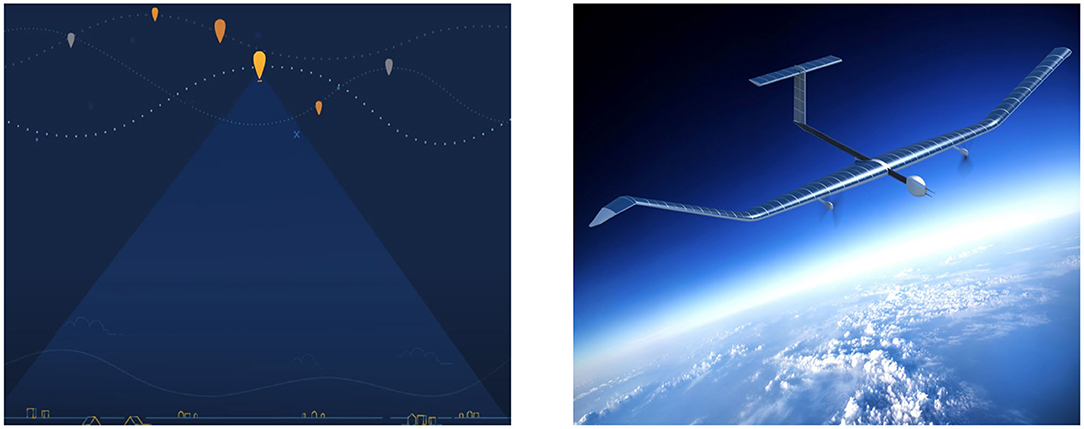
Figure 6. Balloons in Google's Loon project (left) (Google, 2020) and solar-powered drones in Facebook's Zephyr project (right) (Zephyr, 2020) providing internet connectivity to underserved communities.
2.4.3. Emerging Satellite Networks
In the space arena, several industrial partners are joining the race to provide broadband internet access around the globe via thousands of satellites in low Earth orbit (LEO) (Saeed et al., 2020a). Amazon's Project Kuiper (Kuiper, 2020), for example, is planning to deploy 3,236 LEO satellites at altitudes between 590 and 630 km. Starlink (Starlink, 2020) supported by SpaceX, will install 12,000 LEO satellites, while OneWeb (Oneweb, 2020) and Telesat (Telesat, 2020) will place up to 900 satellites in the latter half of 2020. Such a large number of satellites has spurred the mass production of satellite components, resulting in a significant reduction in satellite manufacturing costs. Finally, Astranis (Astranis, 2020) and Gapsat (GapSat, 2020) are making efforts toward a massive deployment of mini-GEO satellites to improve satellite internet capacity worldwide.
2.4.4. Broadband Urban Wireless Connectivity
Beyond enabling or improving connectivity in rural areas, broadband internet is experiencing surging demand in urban and suburban regions. Typically, buried underground fiber-optic cables provide broadband internet; however, these may not be viable in dense urban environments. Therefore, Facebook introduced Terragraph, an integrated backhaul access technology for urban environments by taking the idea of routing in their fiber backbone and applying it into Terragraph technology (Terragraph, 2020). Facebook is testing Terragraph worldwide, claiming an average internet speed of 500 Mbps. One major challenge of the Terragraph technology is that it requires strict line-of-sight conditions since it is operating in the 60-GHz band.
2.5. Challenges and Possible Solutions
In fighting the COVID-19 pandemic, we cannot ignore the positive impact of wireless communication technologies. However, wireless technologies also pose various challenges, with privacy, security, and misinformation. In the following, we discuss each of these issues and their possible solutions separately.
2.5.1. Privacy
Although contact tracing technologies can be quite helpful in curbing the spread of the virus, these also invade people's privacy (McGee et al., 2020). User location information is accessed and monitored by these applications and can be employed by governments for surveillance purposes. Global human rights activists warn that the use of these applications during the pandemic may morph into standard surveillance protocols in the future. Before implementing these applications, governments need to answer a few questions about the use of such data. For example, do users know that their information is being collected, and, once the pandemic is over, can users remove their data? How long will governments retain the data collected during the COVID-19 pandemic? Who will be able to access user data and what are the guidelines for sharing such data? Analogously, the use of drones for monitoring social distancing or tracking sick people in public places raises privacy concerns. Aerial surveillance in general raises serious concerns regarding the infringement of individuals' rights to privacy and freedom (Marketplace Tech, 2020).
The collection of mobile phone data, notably location data, can help curb the spread of viruses but invade people's privacy. Therefore, in some countries, Bluetooth low energy (BLE) technology is preferred since it is less invasive of privacy (Episerver, 2020). In BLE technology, when two users cross each other, their contact tracing Apps broadcast their IDs and record the IDs of nearby users. During this process, the devices exchange information such as time and distance. This information is either kept by the device or shared with a central entity; when a user is infected with COVID-19, all the data gathered by the user's device is added to the cloud system where all other users can get this information. In this approach, if users are identifiable with all the data handled by a central entity, it creates a privacy issue. However, if the user is not recognizable and the central entity is only processing the data for a match, it is viable (Ahmed et al., 2020; Rossello and Dewitte, 2020). Nevertheless, decentralization of the processing can lead to a better privacy preservation approach with the help of distributing AI techniques.
2.5.2. Security
The unprecedented use of fixed and mobile broadband connections during the COVID-19 pandemic is highlighting major cybersecurity risks (Hakak et al., 2020). According to the report of Akamai (Leighton, 2020), in March 2020, global internet traffic increased by 30%, which is 10 times more than the monthly average. This record-breaking level of internet use has created a spike in malicious attacks including phishing emails, malware inserted into COVID-19-related resources, and even the sale of phony cures for COVID-19 (Davies, 2020). In addition, many business employees work remotely from home, and it is challenging to provide authentication for all users. As more businesses move online and follow e-commerce practices, a corresponding increase in cyberattacks is expected (Woollacott, 2020). Also, the automation of industries in which devices are more connected than ever offer opportunities for cybercriminals. New digital technologies that are evolving at rapid rates during the pandemic may need to be classified as high cybersecurity risks.
As the COVID-19 pandemic continues to promote the remote working culture, the cybersecurity risks are continuously growing. In Lallie et al. (2020), the authors have highlighted the timeline of such cyberattacks during the pandemic. The businesses and organizations can safeguard against these cyberattacks by following the Trusted Cyber-Infrastructure (TCI) considerations, such as raising awareness for the employees against COVID-19 related frauds, using multi-factor authentication to access the organizational data, regularly updating the browsers, holding transparent communication with the employees, keeping confidentiality at home, and developing secure collaboration tools for the transfer of data (Trusted CI, 2020). These are some of the near-term solutions to curb the cybersecurity issues during the pandemic. Moreover, cybersecurity professionals and public services can join together to reduce the fraudulent risks, such as the “COVID-19 CTI League” (CTI, 2020), which comprises volunteers mitigating cybersecurity risks amid COVID-19.
2.5.3. Is 5G Really Harmful? Combating the Misinformation
The COVID-19 pandemic has breathed new life into anti-5G conspiracy theories. In a recent interview, the British conspiracy theorist David Icke linked the COVID-19 outbreak to 5G technology. In the interview, he made the claim that Wuhan was the first Chinese city to roll out 5G just before the virus outbreak. However, the claim was false: Wuhan was among several Chinese cities, including Beijing, Shanghai, and Guangzhou, to roll out 5G just prior to the pandemic. Also, the WHO has found no evidence that 5G adversely affects health (ITU News, 2020b). In several countries the fear of 5G has prompted acts of vandalism in which cell towers have been attacked and set on fire (The Guardian, 2020). In order to ensure that communication technology services continue to progress, these conspiracy theories need to be strongly refuted (or regulations adjusted) and the refutations publicized in the media, as wireless communications are now being forced to compete with misinformation. In order to combat this misinformation, researchers around the globe have been working with wireless communication technologies to provide clarifications to fight this misinformation. For example, Peter Popovski, professor of wireless communications at Aalborg University, formulated several key arguments to assuage fears around this new technology: at the moment most wireless devices do not have 5G, and no evidence has been found of 5G adversely affecting human health (Chiaraviglio et al., 2020; Popovski, 2020; Saeed et al., 2020b). The WHO also concluded that, to the best of our knowledge, the radiations from 5G and other communication technologies are not harmful to human health (WHO, 2020). Indeed, wireless communication technologies have been vital in keeping societies functioning during the COVID-19 global lockdown.
With global connectivity, the misinformation spreads more quickly, creating an infodemic. In this regard, the WHO is working with various data analytic companies that collect information from multiple social media platforms and apply machine learning algorithms to classify the information (Alaoui, 2020). This helps the WHO to gain insights regarding the health topics discussed over the social media and to develop timely messages in response. In some countries where is the digital divide problem, the WHO is collaborating with UN Global Pulse to use artificial intelligence and big data to handle the humanitarian issues and disseminate the information in real-time over radio broadcasting (UN Global Pulse, 2020).
3. Survival of the Economy
The extraordinary actions taken across the globe to control the spread of COVID-19 have come at the cost of unprecedented economic loss. There is great contention among the policymakers over saving more lives vs. saving the economy. In this section, we detail the impact of COVID-19 on the global economy and outline the role of wireless communication technologies in rescuing the economy.
3.1. Impact of COVID-19 on the Global Economy
Because of the COVID-19 pandemic, economies around the world are crumbling. The price of every commodity has fallen significantly (World Bank, 2020). Governments are having to make calculated trade-offs between the lives of people who will die of COVID-19 and economic damage (Atkeson, 2020). Over the past 3 months, the world's biggest stock markets have been in the deficit because the investors have had to re-calculate future projections for the economy. The financial crisis of 2007–2008 saw a steady downturn in the economy; however, in the current pandemic, due to strict lockdowns, investors are not purchasing, leading to a global economic recession with low gross domestic product (GDP) growth so far in 2020 (see Figure 7). The downturn began when the Chinese government shut-down its manufacturing sector to prevent the spread of the virus. Since China manufactures one-third of the world's products, the shut-down caused production delay, leading to the disruption of supply chains throughout the world (McKibbin and Fernando, 2020). For instance, the automotive industry relies on specific tools and machinery from China to manufacture automobiles; because of the shutdown of China's manufacturing sector, each of these components has experienced a 1–3 months' delay. This has meant that auto manufactures have not been able to launch new vehicles on time and have lost billions of dollars is sales. The same is true for other industries, in which the drops in sales can lead to layoffs and bankruptcies. One such example is the collapse of OneWeb, a leading small-satellite project with 74 satellites already in orbit providing internet access from space (Amos, 2020). OneWeb was not able to secure new investment during the COVID-19 pandemic.
In order to combat this global pandemic and prepare for continuous disruptions, industries need to respond strategically by moving toward a low-touch or touch-less economy. In such a crisis, a schema such as the COVID-19 strategy matrix can be followed (Table 1) (Board of Innovation, 2020). For example, industries such as e-commerce can still generate ample revenues in the short term and need only keep up with supply; however, the outlook for sectors such as tourism is very uncertain. In the long run, therefore, these sectors must look either at fresh starts or at abandonment. The COVID-19 strategy matrix is shown in Table 1, which relates the impact of COVID-19 to corresponding response strategies for different industries. Now is also the right time for the stakeholders to invest more in research and development (R&D), following the example of the most innovative companies in the global financial crisis of 2007–2008, whose increased investment in R&D has since paid off handsomely in increased growth and profits (Board of Innovation, 2020). Through the development of novel smart solutions, R&D in digital technologies can pave the way for a low-touch economy (Field and Murphys, 2020). Recently, the G20 leaders published a joint statement revealing that digital technologies can significantly help in reducing the transmission of the virus and minimize both the economic and social impact of the COVID-19 pandemic (G20 Summit, 2020). These digital technologies can also monitor the state of the economy. For example, using visible and infrared images from satellites to monitor activity in hot spots, and from an analysis of the resultant geospatial data researchers at WeBank have shown that China's economy is recovering from the first wave of the pandemic. Similarly, Ursa space systems is employing images from their synthetic-aperture radar satellites and data analytics to visualize the impact of COVID-19 on global oil inventories (Werner, 2020). With strict lockdowns, many companies are taking an interest in satellite imagery to collect information about operational activities in areas of concern.

Table 1. Strategic response adaptation (Board of Innovation, 2020).
3.2. Automation of Industries and Supply Chain
As mentioned earlier, two primary reasons for the crumbling of global economies are the shutting down of whole industries and the disruption of supply chains. However, recent advances in the Internet of Things (IoT) can contribute to streamlining supply chains and reducing the impact of the COVID-19 pandemic, as well as playing a significant role in the automation of industries that can further improve the supply chain. For instance, the Industrial Internet of Things (IIoT) can enable smart and adaptive manufacturing by employing smart sensors and reliable connectivity to interconnect and digitalize traditional factories (Sisinni et al., 2018). This allows for the self-organizing, remote monitoring, and collaborative control of conventional industries (see Figure 8). The primary reason for establishing IIoT is that intelligent machines can efficiently collect, communicate, and act in real time. To accomplish this, IIoT requires stable and uninterrupted, massive and ubiquitous high-speed connectivity, latency below 1 ms, and ultra-reliability in order to support real-time monitoring and provide automation. These metrics are characteristics of 5G technology; ergo, the concept of IIoT can be realized by using 5G (Cheng et al., 2018). Moreover, 5G connectivity can potentially transform supply chains by helping companies to precisely measure consumer demand and react in real-time to changing situations.
3.3. E-Commerce
In the midst of the COVID-19 outbreak, e-commerce is emerging as a critical strategy for preserving jobs. For example, restaurants that have closed due to lockdowns can survive by starting online delivery services. Indeed, in some cases, e-commerce is creating new opportunities; Amazon recently announced that it was hiring over 175,000 people to assist existing staff and fulfill customers' delivery demands (Amazon, 2020). The combination of 5G and technologies such as IoT, AI, blockchain, and AR/VR are poised to transform the e-commerce industry (Kshetri, 2018). With 5G connectivity, IoT will enable the fast transfer of data to improve the consumer experience, track real-time inventory, and effectively manage orders. Likewise, AR/VR with 5G connectivity will allow the merchandisers to virtually place physical objects on remote shelves. 5G can offer e-commerce enterprises a unique high-resolution viewing experience, ultimately elevating their capacity. A recent report from Adobe Digital claims that 5G will increase e-commerce revenues by $12billion or more by the year 2021 (Sterling, 2020), since most enterprises are moving toward e-commerce.
3.4. Supporting At-Risk Occupations
For people employed in essential service sectors, working remotely and maintaining social distancing are luxuries. Hence, essential service workers have a high risk of being exposed to the virus. The US Department of Labor has defined an occupational risk score (see Figure 9) based on the characteristics of a particular job, such as the amount of contact with others, the degree of physical proximity, and the risk of exposure to the virus (Lu, 2020). According to this risk score, dental hygienists, bus drivers, and economists are at high, medium, and low risk, respectively. Digital technologies can play significant roles in providing low-touch or touchless solutions for occupations that are at medium or high risk. For example, supermarket workers can be equipped with smart wearable sensors to maintain minimum distances in order to avoid possible contamination with the virus. Similarly, telemedicine with AR/VR capabilities can be used by dental hygienists for contactless procedures. This way, many at-risk workers can be protected, reducing unemployment.
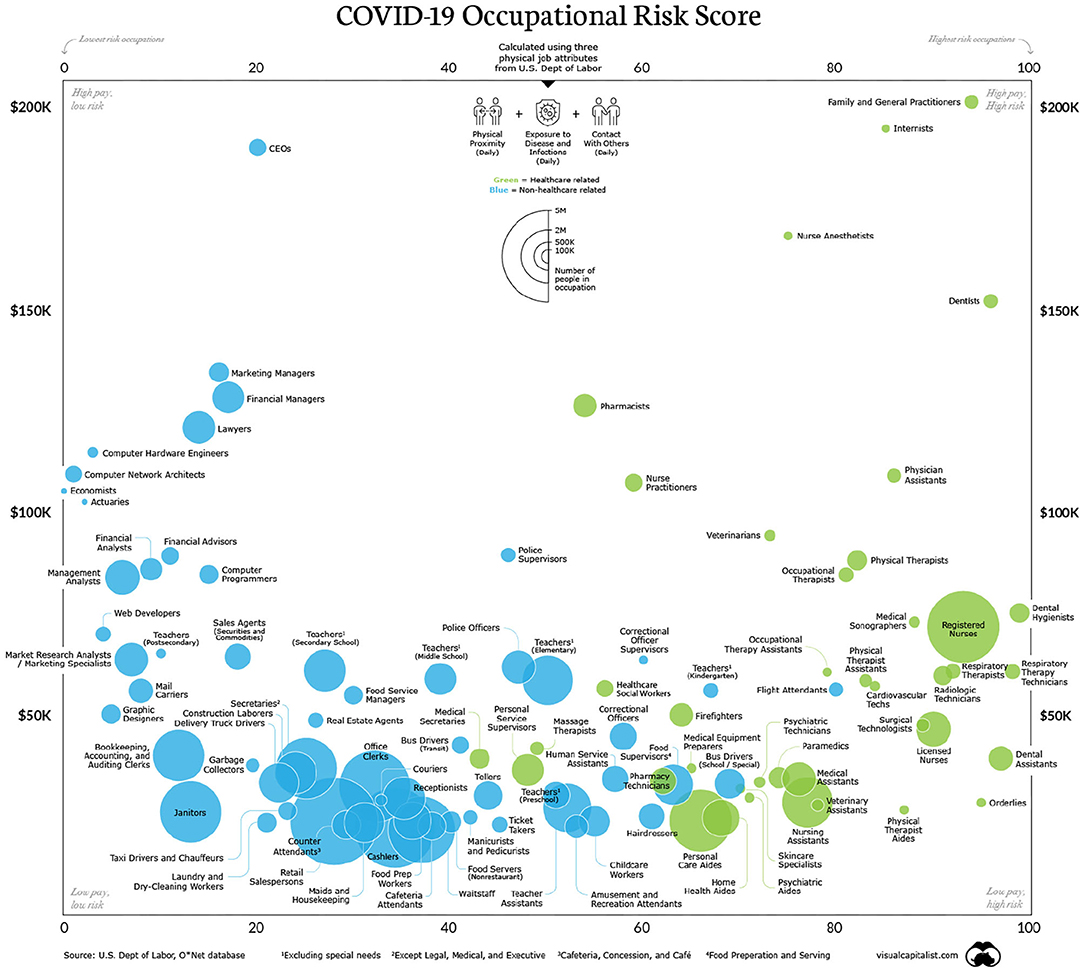
Figure 9. Income and risk factor (0–100) as a function of occupation (Lu, 2020).
3.5. Flattening the Curve
Across the globe, the terminology “flatten the curve” refers to governments' strategy to reduce the spread of the virus, without taking into account the economic consequences of this choice. However, every economic recession also costs lives. Unemployment is already rising; in the US alone, millions of people have lost their jobs in the first 3 weeks of March 2020. Unemployment has been shown to increase the death rate by increasing the incidence of heart disease. Sustainable health systems, healthy nutrition, and clean water may not be available during a deep recession. Hence, long-term shutdowns can indeed “flatten the curve” but can also cost lives. In poorer countries in which the workforce survives on daily incomes, lockdowns can lead to starvation. According to a recent statement from the UN World Food Program (WFP), prolonged shutdowns can lead to “hunger pandemics” (WFP, 2020). As the virus is exhibiting exponential growth in most countries, epidemiological modeling of its spread and socioeconomic impact is essential. As discussed in previous sections, wireless communication technologies, can undoubtedly help in “flattening the curve”, which can in turn lead to the reopening of business and industry. Also, the epidemiological modeling will guide the policymakers to take actions regarding socioeconomic and health considerations.
4. The New Normal
The post-pandemic era, or the “new normal,” is going to be very different from the “old normal,” ushering in a technological revolution. Although by themselves, digital technologies cannot end the pandemic, researchers are delving deeper to discover their true potential. In this section, we cover the wireless communication technologies that have developed during the pandemic and that can be employed in the post-pandemic era.
4.1. The Rise of Telehealth
COVID-19 is a game-changer for the healthcare industry. According to Statista, forecasted revenue for the telehealth sector worldwide will be around $332.7 billion by 2025 (Statista, 2020). These numbers cannot be achieved without efficient and reliable wireless connectivity. IoT, robotics, and AR/VR with high-speed connectivity will truly revolutionize the healthcare industry. These technologies will not only enable medical specialists to analyze patients' data but also allow them to perform remote surgery and other procedures (Marr, 2020). Moreover, these technologies will also reduce travel expenses since the best doctors can be accessed online from anywhere in the world. Telehealth can also maintain the productivity of clinicians who are unable to offer patients in-person visits.
4.2. A More Connected World
The COVID-19 pandemic is demonstrating the true potential of connectivity and interconnected technologies. Across the globe, audio/video applications, such as Google Hangouts, Zoom, and Skype, are keeping people connected and enabling e-learning and teleconferencing. Our dependence on these applications during COVID-19 can pave the way for a remote workforce and a blended education system in the future. Similarly, the blend of 5G and AR/VR can further develop virtual labs, classrooms, and conferencing.
In addition, solutions developed during the pandemic to provide connectivity to rural areas can lead in the long run to overcoming the digital divide.
4.3. Improved Cybersecurity
Besides jeopardizing healthcare systems and the economy, the COVID-19 pandemic is increasing cybersecurity threats. This is mainly due to people's greater dependence on the internet for working remotely during the global lockdown. This dependence creates vulnerabilities to malicious attacks, such as phishing emails, malware insertion in COVID-19-related resources, and even the sale of bogus cures for COVID-19 (Davies, 2020). Moreover, the businesses move online and follow e-commerce practices, more cyberattacks are expected (Woollacott, 2020). Also, industrail automation, in which the devices are more connected than ever, provides opportunities for cybercriminals. While we focus on opportunities “flattening the curve” to prevent the spread of the virus, the increase in cybersecurity threats should also be mitigated. With this in mind, the awareness and cybersecurity tools developed during the pandemic can help online businesses become more robust in the “new normal.”
4.4. The IoT Revolution
In the COVID-19 era, IoT networks are seeing astonishing growth, which will result in the automation of many sectors, including health, manufacturing, consumer electronics, and transportation. With the roll out of 5G, the role of IoT will further increase, leading to applications beyond our imagination, from smart cities and smart oceans to smart space (Saeed et al., 2019a). Rapidly-growing research in the IoT field will also help humanity to better prepare for natural calamities and pandemics in the future.
5. Conclusion
Wireless communication technologies are playing a significant role in winning the fight against pandemic's disruption of everyday life and in looking forward to the “new normal.” In this paper, we discussed the variety of global challenges stemming from the COVID-19 pandemic, and we highlighted the need for wireless communication technologies in facing challenges such as monitoring the spread of the virus, enabling healthcare automation, and allowing virtual education and conferencing. Moreover, we have also discussed the hazards posed by these technologies, such as privacy, security, and the threat of misinformation. Additionally, we also showed that wireless communication technologies are assisting in the survival of the global economy by aiding industries, supply chains, and e-commerce with automation. Finally, we highlighted several use cases that revolutionized wireless communication technologies during the pandemic, promising a technological transformation in the future.
This article motivates the researchers to investigate various wireless communication technologies for the pandemic response. Moreover, government agencies may take necessary initiatives to develop digital solutions outlined in this paper for the frontline workers to ensure their safety. Also, numerous promising wireless communication technologies such as tethered drones/balloons, high-altitude platforms, and small satellite networks can be further explored to counter the digital divide problem amid COVID-19. As we advance, the use of wireless communication technologies opens up for exciting new opportunities like global smart healthcare systems, connected world, and smart education systems. Therefore, it is necessary to further investigate digital technologies amid COVID-19 that will lead to the future resilient and sustainable smart communities, as envisioned in UN “Sustainable Development Goal 11: Make cities and human settlements inclusive, safe, resilient and sustainable” (United Nations, 2020).
Author Contributions
The work was developed as a collaboration among all authors. M-SA, TA-N, and AB conceived the work and suggested the outline of the paper. The manuscript was mainly drafted by NS and was revised and corrected by all co-authors. All authors have read and approved the final manuscript.
Conflict of Interest
AB was employed by Insyab Wireless Limited.
The remaining authors declare that the research was conducted in the absence of any commercial or financial relationships that could be construed as a potential conflict of interest.
The handling editor declared a past co-authorship with one of the authors M-SA.
Acknowledgments
This work was supported by Office of Sponsored Research (OSR) at King Abdullah University of Science and Technology (KAUST). This manuscript has been released as a pre-print at arXiv, Saeed et al. (2020).
References
Ackerman, E. (2020). Telepresence Robots Are Helping Take Pressure Off Hospital Staff. Available online at: https://spectrum.ieee.org/automaton/robotics/medical-robots/telepresence-robots-are-helping-take-pressure-off-hospital-staff (accessed April 20, 2020).
Ahmadi, H., Shakir, M. Z., and Gatherer, A. (2020). Wireless Communication and the Pandemic: The Story So Far. Available online at: https://www.comsoc.org/publications/ctn/wireless-communication-and-pandemic-story-so-far (accessed April 20, 2020).
Ahmed, N., Michelin, R. A., Xue, W., Ruj, S., Malaney, R., Kanhere, S. S., et al. (2020). A survey of COVID-19 contact tracing apps. IEEE Access 8, 134577–134601. doi: 10.1109/ACCESS.2020.3010226
Alaoui, S. (2020). Immunizing the Public Against Misinformation. Available online at: https://unfoundation.org/blog/post/immunizing-the-public-against-misinformation/ (accessed August 16, 2020).
Amazon (2020). Amazon Has Hired 175,000 Additional People. Available online at: https://blog.aboutamazon.com/company-news/amazon-hiring-for-additional-75-000-jobs (accessed May 03, 2020).
Amon, C. (2020). How Mission Critical Connectivity Has Helped the World Adapt to COVID-19–and Prepare for the Next Crisis. Available online at: https://www.weforum.org/agenda/2020/04/how-mission-critical-connectivity-has-helped-the-world-adapt-to-covid-19-and-prepare-for-the-next-crisis/ (accessed April 30, 2020).
Amos, J. (2020). Coronavirus: OneWeb Blames Pandemic for Collapse. Available online at: https://www.bbc.com/news/science-environment-52070949 (accessed April 21, 2020).
Astranis (2020). Four Billion People Still Have No Internet Access. Astranis Is Here To Change That. Available online at: https://www.astranis.com/ (accessed May 06, 2020).
Atkeson, A. (2020). What Will Be the Economic Impact of COVID-19 in the US? Rough Estimates of Disease Scenarios. Technical report, National Bureau of Economic Research.
Board of Innovation (2020). The New Low Touch Economy: How to Navigate the World After COVID-19. Available online at: https://www.boardofinnovation.com/low-touch-economy/ (accessed April 20, 2020).
Chamola, V., Hassija, V., Gupta, V., and Guizani, M. (2020). A comprehensive review of the COVID-19 pandemic and the role of IoT, drones, AI, blockchain, and 5G in managing its impact. IEEE Access 8, 90225–90265. doi: 10.1109/ACCESS.2020.2992341
Chang, M.-C., Kahn, R., Li, Y.-A., Lee, C.-S., Buckee, C. O., and Chang, H.-H. (2020). Modeling the impact of human mobility and travel restrictions on the potential spread of SARS-CoV-2 in Taiwan. medRxiv [Preprint]. doi: 10.1101/2020.04.07.20053439
Cheng, J., Chen, W., Tao, F., and Lin, C.-L. (2018). Industrial IoT in 5G environment towards smart manufacturing. J. Indus. Inform. Integr. 10, 10–19. doi: 10.1016/j.jii.2018.04.001
Chiaraviglio, L., Elzanaty, A., and Alouini, M.-S. (2020). Health risks associated with 5G exposure: a view from the communications engineering perspective. arXiv [Preprint] arXiv:2006.00944.
CTI (2020). CTI League. Available online at: https://cti-league.com/ (accessed August 16, 2020).
Dang, S., Amin, O., Shihada, B., and Alouini, M.-S. (2020). What should 6G be? Nat. Electron. 3, 20–29. doi: 10.1038/s41928-019-0355-6
Davies, N. (2020). Are We Ready for a Post-COVID-19 Cybersecurity Landscape? Available online at: http://www.circleid.com/posts/20200501-are-we-ready-for-a-post-covid-19-cybersecurity-landscape/ (accessed May 03, 2020).
eHealth Network (2020). Mobile Applications to Support Contact Tracing in the EU's Fight Against COVID-19. Available online at: https://ec.europa.eu/health/sites/health/files/ehealth/docs/covid-19_apps_en.pdf (accessed April 20, 2020).
Eisenberg, W. (2020). Johns Hopkins Team Launches Temperature-Tracking Study and App to Map and Monitor Potential COVID-19 Cases. Available online at: https://hub.jhu.edu/2020/04/30/johns-hopkins-covid-temperature-tracking-app/ (accessed May 03, 2020).
Episerver (2020). COVID-19's Impact on Data Privacy, Protection and Security. Available online at: https://www.episerver.com/guides/covid-19-privacy-considerations (accessed August 16, 2020).
Ethirajulu, B. (2020). How 5G and Edge Computing Can Enhance Virtual Reality. Available online at: https://www.ericsson.com/en/blog/2020/4/how-5g-and-edge-computing-can-enhance-virtual-reality (accessed April 28, 2020).
Facebook (2020). Connecting the World. Available online at: https://info.internet.org/en/ (accessed April 28, 2020).
Field, H., and Murphys, M. (2020). COVID-19 Will Herald an Automation Boom. Available online at: https://www.protocol.com/automation-boom-caused-by-coronavirus (accessed April 21, 2020).
G20 Summit (2020). Digitalization Joint Statement in Response to COVID-19. Available online at: https://www.b20saudiarabia.org.sa/wp-content/uploads/2020/04/DIGITALIZATION-JOINT-STATEMENT-IN-RESPONSE-TO-COVID-19-En.pdf (accessed May 28, 2020).
Gallagher, P., Kring, W. R., and Ocampo, J. A. (2020). Calibrating the COVID-19 Crisis Response to the SDGs. Available online at: https://www.un.org/en/un-coronavirus-communications-team/calibrating-covid-19-crisis-response-sdgs (accessed May 05, 2020).
GapSat (2020). GapSat. Available online at: https://spacenews.com/gapsat-ceo-small-geo-needed-to-adapt-business-plan/ (accessed May 06, 2020).
Gent, E. (2020). Forget Video Conferencing-Host Your Next Meeting in VR. Available online at: https://spectrum.ieee.org/tech-talk/consumer-electronics/audiovideo/forget-video-conferencinghost-your-next-meeting-in-vr (accessed April 21, 2020).
Google (2020). Connect People Everywhere. Available online at: https://loon.com/ (accessed April 28, 2020).
Hakak, S., Khan, W. Z., Imran, M., Choo, K. R., and Shoaib, M. (2020). Have you been a victim of COVID-19-Related cyber incidents? survey, taxonomy, and mitigation strategies. IEEE Access 8, 124134–124144. doi: 10.1109/ACCESS.2020.3006172
Hao, K. (2020). Over 24,000 Coronavirus Research Papers Are Now Available in One Place. Available online at: https://www.technologyreview.com/2020/03/16/905290/coronavirus-24000-research-papers-available-open-data/ (accessed April 21, 2020).
Hussain, M. (2020). KAUST Launches vFabLab, Its First Virtual Lab. Available online at: https://vfablab.org/ (accessed April 28, 2020).
IANS (2020). New AI-Driven Drone to Combat Covid-19. Available online at: https://www.expresscomputer.in/artificial-intelligence-ai/new-ai-driven-drone-to-combat-covid-19/53467/ (accessed April 21, 2020).
ITU News (2020a). COVID-19: How Korea is using innovative technology and AI to flatten the curve. Available online at: https://www.itu.int/en/myitu/News/2020/05/06/11/53/COVID19-How-Korea-is-using-innovative-technology-and-AI-to-flatten-the-curve (accessed 20 April 2020).
ITU News (2020b). No Scientific Basis Between 5G and COVID-19. Available online at: https://www.itu.int/en/Pages/COVID-19/5g-covid-19-statement.aspx (accessed April 21, 2020).
ITU News (2020c). Policy and Regulatory Experiences and Best Practices That Can Improve COVID-19 Responses. Available online at: https://www.itu.int/en/ITU-D/Regulatory-Market/Pages/REG4COVID.aspx (accessed April 20, 2020).
ITU News (2020d). Special Emergency Session of the Broadband Commission Pushes for Action to Extend Internet Access and Boost Capacity to Fight COVID-19. Available online at: https://www.itu.int/en/mediacentre/Pages/PR05-2020-Broadband-Commission-emergency-session-internet-COVID-19.aspx (accessed April 20, 2020).
Kaur, H. (2020). The Conspiracy Linking 5G to Coronavirus Just Will Not Die. Available online at: https://edition.cnn.com/2020/04/08/tech/5g-coronavirus-conspiracy-theory-trnd/index.html (accessed April 21, 2020).
Khan, M. A., Saeed, N., Ahmad, A. W., and Lee, C. (2017). Location awareness in 5G networks using RSS measurements for public safety applications. IEEE Access 5, 21753–21762. doi: 10.1109/ACCESS.2017.2750238
Kishk, M. A., Bader, A., and Alouini, M.-S. (2020a). Aerial base station deployment in 6G cellular networks using tethered drones: the mobility and endurance tradeoff. IEEE Vehicular Technology Magazine. doi: 10.1109/MVT.2020.3017885
Kishk, M. A., Bader, A., and Alouini, M. S. (2020b). On the 3-D placement of airborne base stations using tethered UAVs. IEEE Trans. Commun. 68, 5202–5215. doi: 10.1109/TCOMM.2020.2993885
Krauth, D. (2020). Pandemic Drones to Monitor Fever, Crowds From Above. Available online at: https://abc7ny.com/coronavirus-drones-covid-19-pandemic-nj/6102905/ (accessed April 21, 2020).
Kshetri, N. (2018). 5G in E-commerce activities. IT Profession. 4, 73–77. doi: 10.1109/MITP.2018.043141672
Kuiper (2020). Amazon's Kuiper Systems Joins SIA. Available online at: https://www.satellitetoday.com/business/2019/08/19/amazons-kuiper-systems-joins-sia/ (accessed May 06, 2020).
Lageard, J. (2020). How Technology Can Combat COVID-19? Available online at: https://www.techuk.org/insights/opinions/item/17314-guest-blog-how-technology-can-combat-covid-19 (accessed April 20, 2020).
Lallie, H. S., Shepherd, L. A., Nurse, J. R. C., Erola, A., Epiphaniou, G., Maple, C., et al. (2020). Cyber security in the age of COVID-19: a timeline and analysis of cyber-crime and cyber-attacks during the pandemic. arXiv [Preprint] arXiv:2006.11929.
Leighton, T. (2020). Can the Internet Keep Up With the Surge in Demand? Available online at: https://blogs.akamai.com/2020/04/can-the-internet-keep-up-with-the-surge-in-demand.html (accessed May 10, 2020).
Lu, M. (2020). The Front Line: Visualizing the Occupations With The Highest COVID-19 Risk. Available online at: https://www.visualcapitalist.com/the-front-line-visualizing-the-occupations-with-the-highest-covid-19-risk/ (accessed April 20, 2020).
Marketplace Tech (2020). Safety or Surveillance: Drones and the COVID-19 Pandemic. Available online at: https://www.marketplace.org/shows/marketplace-tech/covid-19-pandemic-drones-safety-surveillance/ (accessed May 10, 2020).
Marr, B. (2020). 9 Future Predictions for a Post-Coronavirus World. Available online at: https://www.forbes.com/sites/bernardmarr/2020/04/03/9-future-predictions-for-a-post-coronavirus-world/#926984d54106 (accessed April 20, 2020).
McGee, P., Murphy, H., and Bradshaw, T. (2020). Coronavirus Apps: The Risk of Slipping Into a Surveillance State. Available online at: https://www.ft.com/content/d2609e26-8875-11ea-a01c-a28a3e3fbd33 (accessed May 10, 2020).
McKibbin, W. J., and Fernando, R. (2020). “The global macroeconomic impacts of COVID-19: seven scenarios,” CAMA Working Paper. Canberra, ACT.
McNeil, D. G. (2020). Can Smart Thermometers Track the Spread of the Coronavirus? Available online at: https://www.nytimes.com/2020/03/18/health/coronavirus-fever-thermometers.html (accessed April 20, 2020).
Meisenzahl, M. (2020). ‘Pandemic Drones’ Could Single People Out in a Crowd for Coughing, Sneezing, or Running a Temperature, Developers Say–Here'S How They Work. Available online at: https://www.businessinsider.com/draganfly-pandemic-drone-will-detect-people-infected-with-coronavirus-2020-4 (accessed April 21, 2020).
Nguyen, C. T., Saputra, Y. M., Huynh, N. V., Nguyen, N. T., Khoa, T. V., Tuan, M. B., et al. (2020). Enabling and emerging technologies for social distancing: a comprehensive survey. arXiv [Preprint] arXiv:2005.02816.
Nordrum, A. (2020). AT&T Feud With FreeConferenceCall.com Heats Up. Available online at: https://spectrum.ieee.org/tech-talk/telecom/wireless/att-feud-freeconferencecallcom-heats-up (accessed April 21, 2020).
Oneweb (2020). Whereever You Are, We Will Cover You. Available online at: https://oneweb.world (accessed May 06, 2020).
Popovski, P. (2020). 5G Technology: Why Not to Worry and What To Do If You Are Still Afraid of It. Available online at: https://link.medium.com/mP6rYvSQq5 (accessed April 21, 2020).
Proximity Trace (2020). In the Time of COVID-19–How Will You Maintain Safe Working Distances? Available online at: https://www.triaxtec.com/resource/fact-sheet/proximity-trace/ (accessed April 21, 2020).
Reynolds, E. (2020). Flying Cellphone Towers: COuld Drones Bring Internet Coverage to Remote Areas? Available online at: https://edition.cnn.com/2020/02/19/tech/tethered-drones-internet-africa-intl/index.html (accessed May 8, 2020).
Richardson, M. (2020). Pandemic Drones: Useful For Enforcing Social Distancing or for Creating a Police State? Available online at: https://gcn.com/articles/2020/03/31/pandemic-drones.aspx (accessed April 21, 2020).
Rossello, S., and Dewitte, P. (2020). Anonymization by Decentralization? The Case of COVID-19 Contact Tracing Apps. Available online at: https://europeanlawblog.eu/2020/05/25/anonymization-by-decentralization-the-case-of-covid-19-contact-tracing-apps/ (accessed August 16, 2020).
Saarnisaari, H., Dixit, S., Alouini, M.-S., Chaoub, A., Giordani, M., Kliks, A., et al. (2020). A 6G white paper on connectivity for remote areas. arXiv [Preprint] arXiv:2004.14699.
Saeed, N., Alouini, M.-S., and Al-Naffouri, T. Y. (2019a). Towards the internet of X-things: new possibilities for underwater, underground, and outer space exploration. arXiv [Preprint] arXiv:1903.11996.
Saeed, N., Bader, A., Al-Naffouri, T. Y., and Alouini, M.-S. (2020). When wireless communication faces COVID-19: combating the pandemic and saving the economy. arXiv [Preprint] arXiv:2005.06637.
Saeed, N., Elzanaty, A., Almorad, H., Dahrouj, H., Al-Naffouri, T. Y., and Alouini, M.-S. (2020a). Cubesat communications: recent advances and future challenges. IEEE Commun. Surv. Tutorials 22, 1839–1862. doi: 10.1109/COMST.2020.2990499
Saeed, N., Loukil, M. H., Sarieddeen, H., Al-Naffouri, T. Y., and Alouini, M.-S. (2020b). Body-Centric Terahertz Networks: Prospects and Challenges. Available online at: https://repository.kaust.edu.sa/handle/10754/664913 (accessed August 5, 2020).
Saeed, N., Nam, H., Al-Naffouri, T. Y., and Alouini, M.-S. (2019b). A state-of-the-art survey on multidimensional scaling-based localization techniques. IEEE Commun. Surv. Tutor. 21, 3565–3583. doi: 10.1109/COMST.2019.2921972
Saeed, N., Nam, H., Haq, M. I. U., and Muhammad Saqib, D. B. (2018). A survey on multidimensional scaling. ACM Comput. Surv. 51, 1–25. doi: 10.1145/3178155
Saeed, N., and Stojkoska, B. R. (2016). Robust localisation algorithm for large scale 3D wireless sensor networks. Int. J. Ad Hoc Ubiquit. Comput. 23, 82–91. doi: 10.1504/IJAHUC.2016.078481
Sisinni, E., Saifullah, A., Han, S., Jennehag, U., and Gidlund, M. (2018). Industrial internet of things: challenges, opportunities, and directions. IEEE Trans. Indus. Inform. 14, 4724–4734. doi: 10.1109/TII.2018.2852491
Starlink (2020). SpaceX Submits Paperwork for 30,000 More Starlink Satellites. Available online at: https://spacenews.com/spacex-submits-paperwork-for-30000-more-starlink-satellites/ (accessed May 06, 2020).
Statista (2020). Statista Dossier on the Global m-Health Industry and Market. Available online at: https://www.statista.com/study/24501/mhealth-statista-dossier/ (accessed May 04, 2020).
Sterling, G. (2020). 5G Will Drive $12 Billion in New Mobile Commerce Revenue by 2021. Available online at: https://marketingland.com/report-5g-will-drive-12-billion-new-mobile-commerce-revenue-2021-235416 (accessed May 03, 2020).
Telesat (2020). Telesat LEO: Why LEO? Available online at: https://www.telesat.com/services/leo/why-leo (accessed May 06, 2020).
Terragraph (2020). Terragraph Solving the Urban Bandwidth Challenge. Available online at: https://terragraph.com/ (accessed May 06, 2020).
Thales (2020). What's Up With Stratobus? Available online at: https://www.thalesgroup.com/en/taxonomy/term/7436 (accessed August 5, 2020).
The Guardian (2020). UK Phone Masts Attacked Amid 5G-Coronavirus Conspiracy Theory. Available online at: https://www.theguardian.com/uk-news/2020/apr/04/uk-phone-masts-attacked-amid-5g-coronavirus-conspiracy-theory (accessed April 20, 2020).
Ting, D. S. W., Carin, L., Dzau, V., and Wong, T. Y. (2020). Digital technology and COVID-19. Nat Med. 26, 459–61. doi: 10.1038/s41591-020-0824-5
Trusted CI (2020). Recommendations for Reducing Cybersecurity Risk While Working Remotely. Available online at: https://blog.trustedci.org/2020/03/recommendations-for-reducing.html/ (accessed August 16, 2020).
UN Global Pulse (2020). Understanding the COVID-19 Pandemic in Real-Time. Available online at: https://www.unglobalpulse.org/project/understanding-the-covid-19-pandemic-in-real-time/ (accessed August 16, 2020).
United Nations (2020). Goal 11: Make Cities and Human Settlements Inclusive, Safe, Resilient and Sustainable. Available online at: https://unstats.un.org/sdgs/report/2016/goal-11/ (accessed July 16, 2020).
Waltz, E. (2020). How Facebook and Google Track Public'S Movement in Effort to Fight COVID-19. Available online at: https://spectrum.ieee.org/the-human-os/telecom/wireless/facebook-google-data-publics-movement-covid19 (accessed April 20, 2020).
Werner, D. (2020). Pandemic Fuels Demand for Satellite Imagery. Available online at: https://spacenews.com/earth-imagery-demand-pandemic/ (accessed April 21, 2020).
WFP (2020). WFP Chief Warns of Hunger Pandemic as COVID-19 Spreads. Available online at: https://www.wfp.org/news/wfp-chief-warns-hunger-pandemic-covid-19-spreads-statement-un-security-council (accessed April 30, 2020).
WHO (2020). 5G Mobile Networks and Health. Available online at: https://www.who.int/news-room/q-a-detail/5g-mobile-networks-and-health/ (accessed July 16, 2020).
Woollacott, E. (2020). Cybersecurity and COVID-19-the First 100 Days. Available online at: https://www.forbes.com/sites/emmawoollacott/2020/05/05/exclusive-cybersecurity-and-covid-19the-first-100-days (accessed May 05, 2020).
World Bank (2020). The Economy in the Time of Covid-19. Available online at: https://openknowledge.worldbank.org/handle/10986/33555 (accessed April 20, 2020).
Xiaoxia, Q. (2020). How Next-Generation Information Technologies Tackled COVID-19 in China. Available online at: https://www.weforum.org/agenda/2020/04/how-next-generation-information-technologies-tackled-covid-19-in-china/ (accessed April 25, 2020).
Yaacoub, E., and Alouini, M. S. (2020). “A key 6G challenge and opportunity-connecting the base of the pyramid: a survey on rural connectivity,” in Proceedings of the IEEE, 108, 533–582. doi: 10.1109/JPROC.2020.2976703
Zephyr (2020). Zephyr Pioneering the Stratosphere. Available online at: https://www.airbus.com/defence/uav/zephyr.html (accessed May 8, 2020).
Zhu, N., Zhang, D., Wang, W., Li, W., Yang, B., Song, J., et al. (2020). A novel coronavirus from patients with pneumonia in China, 2019. N. Engl. J. Med. 382, 727–733. doi: 10.1056/NEJMoa2001017
Zolli, A. (2020). How satellite data can help with COVID-19 and beyond. Available online at: https://www.planet.com/pulse/how-satellite-data-can-help-with-covid-19-and-beyond/ (accessed April 21, 2020).
Keywords: COVID-19, digital technologies, wireless communication, healthcare automation, virtual education, e-commerce
Citation: Saeed N, Bader A, Al-Naffouri TY and Alouini M-S (2020) When Wireless Communication Responds to COVID-19: Combating the Pandemic and Saving the Economy. Front. Comms. Net. 1:566853. doi: 10.3389/frcmn.2020.566853
Received: 28 May 2020; Accepted: 14 September 2020;
Published: 23 November 2020.
Edited by:
Muhammad Zeeshan Shakir, University of the West of Scotland, United KingdomReviewed by:
Alexandros-Apostolos A. Boulogeorgos, University of Piraeus, GreeceYasmin Fathy, University of Cambridge, United Kingdom
Jawwad Latif, University of the West of Scotland, United Kingdom
Copyright © 2020 Saeed, Bader, Al-Naffouri and Alouini. This is an open-access article distributed under the terms of the Creative Commons Attribution License (CC BY). The use, distribution or reproduction in other forums is permitted, provided the original author(s) and the copyright owner(s) are credited and that the original publication in this journal is cited, in accordance with accepted academic practice. No use, distribution or reproduction is permitted which does not comply with these terms.
*Correspondence: Nasir Saeed, bmFzaXIuc2FlZWRAa2F1c3QuZWR1LnNh
 Nasir Saeed
Nasir Saeed Ahmed Bader
Ahmed Bader Tareq Y. Al-Naffouri1
Tareq Y. Al-Naffouri1 Mohamed-Slim Alouini
Mohamed-Slim Alouini